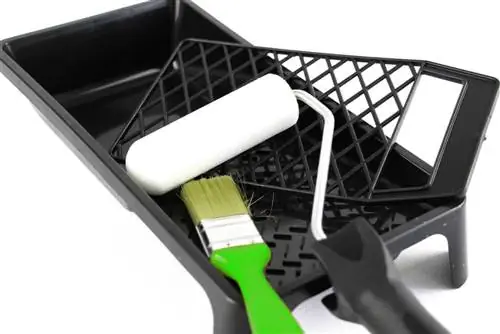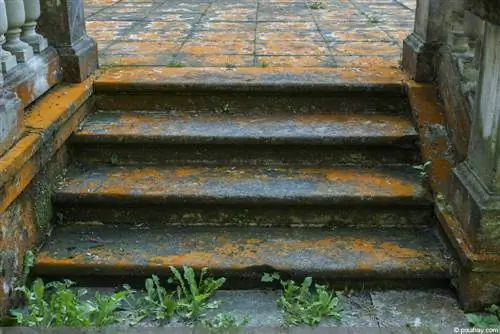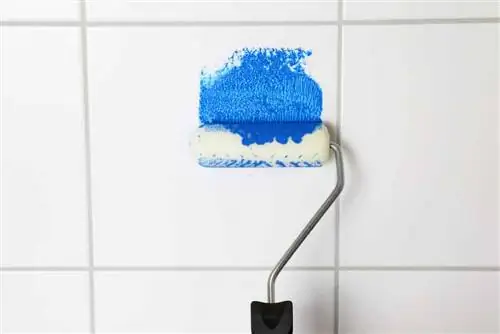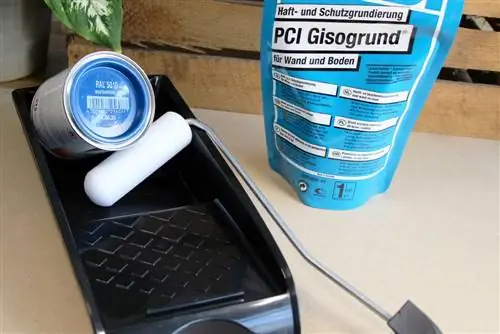- Author admin [email protected].
- Public 2023-12-17 03:39.
- Last modified 2025-06-01 06:48.
Dark blue, intense red, anthracite or even black - dark wall colors as contrasting accents or cozy interior decor are always in trend. However, they can prove to be a challenge when moving or remodeling, as painting over often requires a lot of effort. The following tips and instructions will help.
High-quality colors
If you want to paint over dark wall paint, you often come across a typical problem: Even after two or three coats, the wall still appears dark or stained. This is often due to the poor quality or opacity of the overpaint. If five to six layers are not to be applied, the following points should be taken into account:
1. Opacity class or contrast ratio
This classification takes place in four stages. The strongest coverage is in class 1 coverage. If you want the least effort when painting over, you should choose colors in this category as it has the highest pigment density.
2. Choose high wet abrasion resistance
Just like the opacity or pigment density, the abrasion resistance is also divided into different classes. There are five classes - with class 1 being the highest quality category.
3. Don't save in the wrong place
Many people are tempted by offers or generally low prices. A bucket of paint for 10 euros is bought faster than high-quality wall paint for 30 euros or more. That's understandable - but unfortunately it means saving money in the wrong place. On the one hand, cheaper products require significantly more wall paint to be used, which increases material consumption and thus the overall costs. On the other hand, the effort required for painting is also significantly higher.
It is therefore better and overall more economical to choose a paint with high opacity. If necessary, this can also be slightly diluted, which in turn reduces the overall costs.
Use primer
If the colors are not only dark but difficult to cover - such as latex paint, chalkboard paint or magnetic paint - even a high-coverage overcoat is not enough. It is then better to use a combined primer or adhesive base and a wall paint with strong coverage.
Same color type
Lime paint or clay paint? Good adhesion and coverage is achieved even when the same type of paint is used to paint over.
Of course, this only works if the color type is known. If you have not previously painted the wall yourself, you can either get an expert opinion or, if in doubt, apply a primer first. This may seem more expensive and time-consuming at first, but it can save both costs and working time.
Matching utensils
If the walls appear stained after painting or the intense, dark tones shine through, this may be due not only to the colors chosen, but also to the utensils. Worn brushes or used rollers apply paint unevenly, making painting more difficult.

The accessories should therefore be checked before painting. If the bristles have become brittle due to long or incorrect storage or the paint rollers are sticky in places, the utensils should be replaced urgently.
Ideal are:
- small brushes, for pre-painting corners and edges
- small paint rollers, for pre-painting and painting transitions
- large paint roller with medium-high pile, for painting larger areas
Paint rollers with simulated or artificial lambskin, for example, are well suited. With these it is comparatively easy to apply thicker layers of paint evenly and quickly over larger areas.
Correct technique for corners and edges
Dark wall colors can prove difficult to show through, especially in the corners and edges. However, with the right technology this can be avoided. The following steps show how to do it:
- Tape off skirting boards and door frames or, if possible, remove the skirting boards for painting. This makes painting easier and “colorful” edges are avoided.
- Painting starts in the corners of the room. To do this, the color is first applied with a brush. It is advisable to first carry out stroking movements and then dab with the brush. This allows a more even distribution of color to be achieved, especially on rough walls. The paint should be allowed to dry for a few minutes, but this will happen automatically as you continue to paint all the corners and edges.
- A small paint roller is used for the transitions between the corners and edges and the larger wall surfaces. It allows you to work closer to the edges, which in turn allows for a more even distribution of color and better coverage.
- After the corners and edges have been painted, the larger wall surfaces are painted with a large roller.
Even with high-quality paints with high opacity, two coats are usually necessary to properly cover the dark tone underneath. The paint should be allowed to dry for a few hours before the second coat. Otherwise there is a risk that it will literally be pulled off again with the paint roller. The drying time of course depends on how warm and dry the air and walls are.






